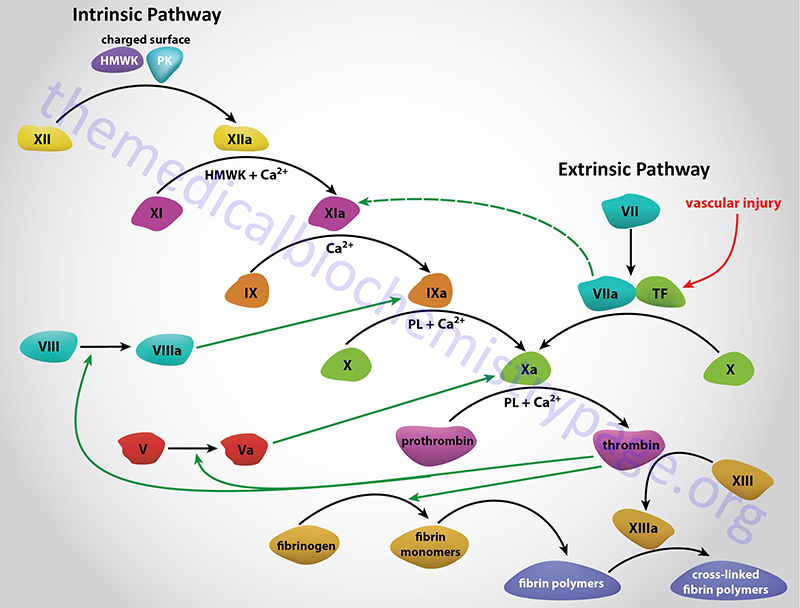Last Updated: October 28, 2025
Introduction to Factor XII
Factor XII is also know, historically, as Hageman factor. Factor XII is involved in the activation of the intrinsic coagulation cascade. The intrinsic coagulation cascade is activated by contact of a complex with a negatively charged surface. This complex consists of prekallikrein (PK), high molecular weight kininogen (HMWK), and factor XII, as well as phospholipids and Ca2+ that were secreted by platelets.
The factor XII protein contains multiple domains that are homologous to domains found in tissue type plasminogen activator (tPA) and fibronectin.
The charged surface that constitutes the contact activation can be the phosphatidylethanolamine present in chylomicrons, VLDL, and oxidized LDL. This is the basis of the role of hyperlipidemia in the promotion of a pro-thrombotic state and the development of atherosclerosis. Contact activation can also occur on the surface of bacteria, and through the interaction with urate crystals, fatty acids, protoporphyrin, amyloid β, and homocysteine.
The assemblage of contact phase components results in conversion of prekallikrein to kallikrein, which in turn activates factor XII to factor XIIa. Factor XIIa then activates factor XI to factor XIa. Factor XIIa will also hydrolyze more prekallikrein to kallikrein, establishing a reciprocal activation cascade. Kallikrein acts upon HMWK leading to the release of bradykinin, a potent vasodilator.
Molecular Biology of Factor XII
Factor XII is encoded by the F12 gene. The F12 gene is located on chromosome 5q35.3 and is composed of 15 exons that encode a 615 amino acid preproprotein.
Unlike the majority of eukaryotic mRNA genes, the promoter region of the F12 gene does not contain the typical TATA-box nor the CAAT-box. This gene structure explains why multiple sites of transcriptional initiation have been identified in the F12 gene.
At least 20 different mutations in the F12 gene have been identified in factor XII deficiency patients. Two missense mutations in the F12 gene have been identified as the causes of hereditary angioedema type III.
Clinical Features of Factor XII Deficiency
A deficiency of the blood coagulation factor XII was first described in 1955 and initially named Hageman factor deficiency after the name of the index case (index case is the first individual identified with a particular phenotype). The original cases were described as having markedly prolonged clotting times. The frequency of factor XII deficiency is unknown as individuals carrying mutations in the gene can lack associated symptoms.
The symptoms of factor XII deficiency do not manifest with spontaneous or post-surgical bleeding but rather are diagnosed when an incidental activated partial thromboplastin time (aPTT) is markedly prolonged in an otherwise asymptomatic patient. The aPTT is a test used to measure the performance of both the intrinsic and extrinsic coagulation cascades. A definitive diagnosis of factor XII deficiency is accomplished by a modified aPTT using factor XII-deficient plasma.

